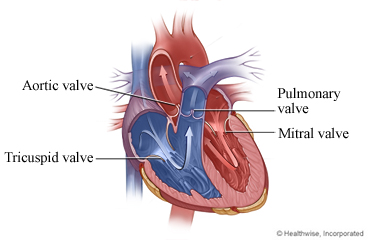Valvuloplasty for Valve Stenosis: Before Your Child's Procedure

What is valvuloplasty?
Valvuloplasty can be done to treat some congenital heart problems. This is a kind of heart problem that your child is born with.
One of the problems this procedure can treat is called valve stenosis. Valve stenosis is the narrowing of a heart valve. It affects how well blood flows through the heart or blood vessels.
Your doctor doesn't need to make any cuts to do the procedure. Instead, the doctor uses a thin tube called a catheter. First, the doctor puts the catheter into a blood vessel. It is usually placed in your child's groin. Then the doctor moves the catheter through the blood vessel until it reaches the heart valve. Next, a tiny balloon is put into the catheter. Then the doctor inflates the balloon to stretch and widen the valve. Then the doctor deflates the balloon and removes it and the tube from your child's body. This procedure allows blood to flow more easily through the heart.
Your child may be able to go home the same day. Your child will continue to see the doctor to be sure the valve is working as it should.
It can be scary when your child has a heart problem. It may help to learn as much as you can about your child's condition. You may also want to talk with other parents who have a child with a similar problem.
How do you prepare for the procedure?
Procedures can be stressful for both your child and you. This information will help you understand what you can expect. And it will help you safely prepare for your child's procedure.
Preparing for the procedure
Talk to your child about the procedure. Say that it will help make your child's heart healthier. Hospitals know how to take care of children. The staff will do all they can to make it easier for your child.
Ask if the hospital has child life specialists. They can help you and your child understand your child's health condition, prepare for the surgery, and get emotional support.
Ask if a special tour of the surgery area and hospital is available. This may make your child feel less nervous about what happens.
Plan for your child's recovery time. He or she may need more of your time right after the procedure, both for care and for comfort.
Understand exactly what procedure is planned, along with the risks, benefits, and other options.
Tell the doctor ALL the medicines and natural health products your child takes. Some may increase the risk of problems during the procedure. Your doctor will tell you if your child should stop taking any of them before the procedure and how soon to do it.
The day before the procedure
- A nurse may call you (or you may need to call the hospital). This is to confirm the time and date of your child's procedure and answer any questions.
- Remember to follow your doctor's instructions about your child taking or stopping medicines before the procedure. This includes over-the-counter medicines.
What happens on the day of the procedure?
Follow the instructions exactly about when your child should stop eating and drinking. If you don't, the procedure may be cancelled. If the doctor told you to have your child take any medicines on the day of the procedure, have your child take them with only a sip of water.
Have your child take a bath or shower before you come in. Do not apply lotion or deodorant.
Your child may brush their teeth. But tell your child not to swallow any toothpaste or water.
Be sure your child has something that's a reminder of home. A special stuffed animal, toy, or blanket may be comforting. For an older child, it might be a book or music.
At the hospital or procedure centre
- A parent or legal guardian must accompany your child.
- Your child will be kept comfortable and safe by an anesthesia provider.
- The procedure will take at least 1 hour. In some cases, it may take several hours.
- After the procedure, your child will be taken to the recovery room. As your child wakes up, the recovery room staff will monitor your child's condition. The doctor will talk to you about the procedure.
- Pressure will be applied to the area where the catheter was put into the blood vessel. Then the area may be covered with a bandage or a compression device. This will prevent bleeding. Nurses will check the area often.
- If the catheter was put in your child's groin, your child will need to lie still and keep the leg straight for up to a few hours.
- Your child may have a bruise or a small lump where the catheter was put in the blood vessel. This is normal and will go away.
When should you call your doctor?
- You have questions or concerns.
- You don't understand how to prepare your child for the procedure.
- Your child becomes ill before the procedure (such as fever, flu, or a cold).
- You need to reschedule or have changed your mind about your child having the procedure.
Current as of: July 31, 2024
